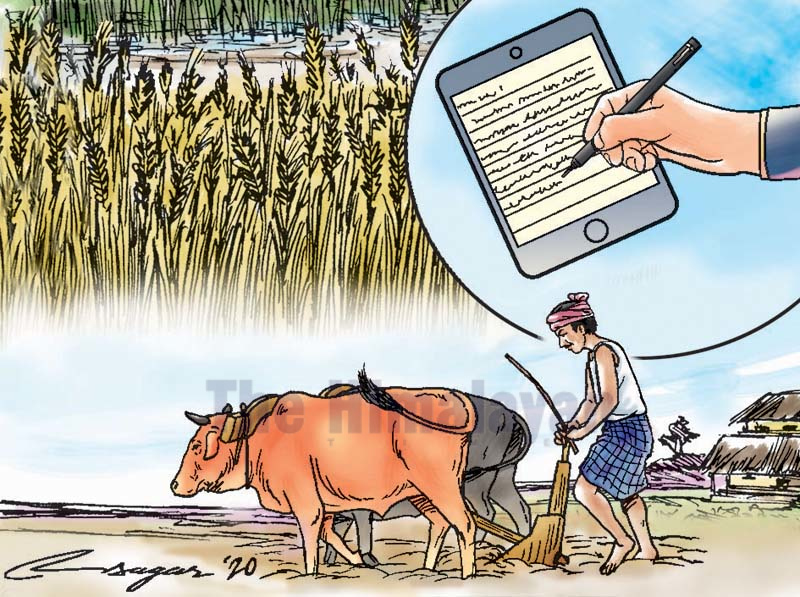Food security: Agricultural sustainability holds the key
In order to ensure food security and a healthy diet, small farm holders mainly from the remote areas must be made economically stronger. If the government were to regulate localised farming in the rural areas, most areas of Nepal would contribute significantly to the national food market, ensuring food security
Agriculture is a nature-dependent human activity indispensable for the continuation and sustenance of human life.
Ironically, while being dependent on nature, it also poses several threats to it.
Agriculture is and will continue to be the core issue for conservation. Today, the global population is rising consistently and the longterm productivity/arability of land is being compromised by chemical fertilisers, pesticides, climate change as farmers have the responsibility to feed the whole world with limited resources.
Food and Agriculture Organisation (FAO) estimates that by 2050, the world population will reach 9.15 billion, and to meet the food demand, global agricultural production will need to increase by 60% compared to 2005-07 and by 77% in the developing countries. Such analysis and forecast by FAO suggest that pressure is building upon the land resources as 70% of the world land area will be covered by urban areas by 2050.
Often credited for saving one billion people from famine in South Asia and other regions with rapid population growth, the Green Revolution of the 1960s has resulted in significant negative effects on food production, including degradation of the soil and over exploitation of the natural resources. This coupled with climate change is likely to cause a shortage of food, or famine, in the near future. Hence, to secure the right to food of future generations, sustainability in agriculture is a must.
Preserving the environment and providing safe and healthy diets for all must be embraced by all sectors and stakeholders who are involved in agriculture and nature conservation.
Sustainable agriculture is an integrated system of plant and animal production practices, having a site specific application that is capable of lasting at a certain level over a longer period of time. The primary benefits of sustainable agriculture are environment preservation, protection of public health, sustaining vibrant communities and upholding animal welfare.
Around the globe, agricultural technologies are shifting from production-oriented to profit-oriented sustainable farming.
Farmers are adopting resource conserving technologies like organic farming, permaculture, carbon farming, ecological intensification, crop rotation, integrated pest and nutrient management, minimum tillage and many more.
Wise selection of each of the aforementioned approaches must be done as their validity is only justified in a given set of specific circumstances.
In Nepal, too, many sustainable agricultural approaches are being adopted.
Adoption of minimum tillage in wheat and lentil cultivation, practice of intercropping and mixed cropping, use of biogas, water mills and drip irrigation technology can be taken as references. Similarly gravity ropeway technology is used in Marpha and Tukche of Mustang district to facilitate apple transportation from orchards to roadways.
Organic agriculture first appeared as a priority sector in Nepali agriculture in the 10th five-year plan(2059/60-2063/64). As a result, Jumla was declared as an organic district in 2064 BS. A decade later, the newly formed Karnali Province declared itself as an “Organic Province” through its very first policy and programmes in 2018/19. The Federal Government has also prioritised sustainable agriculture in its budget statement.
According to FAO’s 2020 report entitled “State of Food Security and Nutrition in the World”, more than 2 billion people in the world do not have regular access to safe, nutritious and sufficient food. And the COVID-19 pandemic may add between 83 and 132 million people to the total number of undernourished in the world.
In Nepal, 4.6 million people are food insecure, and majority of them belong to the rural communities. The foremost causes of food insecurity are lack of access to adequate and nutritious food mainly due to poverty, natural calamities, deficient incomes and climate change.
Food security is dependent upon food being available in the national market, whether it is produced domestically or in other countries.
The cost of nutritious food must come down. The cost drivers of healthy diets, seen throughout the food chain, the food environment and the political economy, need to be regulated.
In order to ensure food security and a healthy diet, small farm holders mainly from the remote areas must be made economically stronger. If the government were to regulate localised farming in the rural areas, most areas of Nepal would contribute significantly to the national food market, ensuring food security. The cost of nutritious food and a healthy diet must be low so that all people can have access to it.
Earning sufficient income from agriculture is a must for those who work in this sector, which directly determines their food security.
Nepal which boasts about the southern plains being its granary should focus on increasing production through sustainable ways. Providing subsidies on seeds, fertilisers, irrigation and storage facilities, fixing minimum farm gate price and investment in marketing and processing of agricultural products are vital to ensure food security.
Similarly, focus should be on future smart crops.
Collective actions of the government, I/NGOs, the media and the general public is a must to ensure food security and sustainability in agriculture. The target of Sustainable Development Goal(SDG) 2 is especially to “end hunger, achieve food security and improved nutrition and promote sustainable agriculture” by 2030. This is only possible through our collective efforts. We all need to adopt healthy food choices and should not waste food. We should not let sustainable habits fall way side in the time of the COVID 19 crisis and must support the government to continue sustainable approaches.






